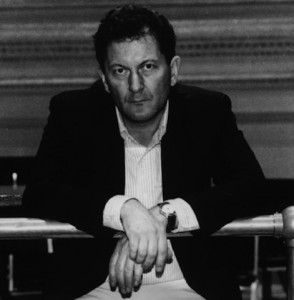Here’s how Phil Kline celebrates the holidays, with a moving installation “boombox” symphony.
Unsilent Night festivities took place in a number of venues in 2010 as well: keep an eye out for videos on YouTube.
Getting ready to enjoy all those new, happy/shiny Xmas presents, I’m sure… Well, here’s another that won’t cost you a dime:
S21’s WPRB-favorite-son, announcer Marvin Rosen, is getting a jump on the upcoming Alan Hovhaness centennial with a 24-hour marathon broadcast of Hovhaness’s music (that’s Marvin above, in 1992, with Hovhaness at the composer’s home). “Mountains and Rivers Without End” begins Sunday, Dec. 26th at 7pm, and will feature more Hovhaness than you can shake a stick at (I know more than a few composers who might well be furiously shaking that stick, but I myself am pretty partial to this American original). Two guests during the marathon will be clarinetist and conductor Lawrence Sobol (December 26, evening), and pianist Sahan Arzruni (December 27, early afternoon) both of whom have recorded the composer’s music. In the New York/New Jersey area you can tune to WPRB at 103.3 FM, while the rest of can stream it all live online.
Marvin is about as well-positioned as anyone to lead you through Hovhaness’s vast output; his doctoral dissertation was on Hovhaness’s music; he was a friend of the composer for many years and spent two weeks in Seattle working with him on his piano music in preparation for the first of two recordings on the Koch International Classics label. Marvin also wrote the liner notes for other Hovhaness recordings on the Koch International Classics label as well. And Marvin has one of the most extensive rare collections of Hovhaness’s music both on CD and LP, so there are bound to be many treats heard. So turn out to tune in, and give Marvin some virtual caffeine support through the long night and day!
 It’s not uncommon to see articles both decrying the sad state of affairs in classical music as a whole as well as celebrating the new opportunities that are available for both composers and performers with the right amount of musical and entrepreneurial skill, luck and perseverance. A prime example of one that covers both issues was recently published as a transcript of a speech given by the Guardian’s Tom Service with the intentionally controversial title “So long, and thanks for all the noise: 2010 and the end of musical history”. Well-spoken and thoughtful (and without the acidity of many critics from across the pond), Service writes:
It’s not uncommon to see articles both decrying the sad state of affairs in classical music as a whole as well as celebrating the new opportunities that are available for both composers and performers with the right amount of musical and entrepreneurial skill, luck and perseverance. A prime example of one that covers both issues was recently published as a transcript of a speech given by the Guardian’s Tom Service with the intentionally controversial title “So long, and thanks for all the noise: 2010 and the end of musical history”. Well-spoken and thoughtful (and without the acidity of many critics from across the pond), Service writes:
My sense is that many young composers now realise that the game is up, that the conventional paths to fame and, er, fortune in contemporary classical culture just aren’t worth the candle. Instead, they’re better off on their own, not least because their music doesn’t fit the line-ups of an orchestra, or even the 1 to a part ensembles of the Sinfonietta, or the Birmingham Contemporary Music Group, or Liverpool’s Ensemble 10:10, or Manchester’s Psappha – a line-up and repertoire whose time has probably also come, has also become a living history more than something genuinely contemporary. Composers still need to make choices, of course; being open to the rest of the world does not guarantee the creation of great, or even good art in an of itself, and they will have to find their own limitations, draw their own lines in the shifting sands of musical culture. But composing without the fear of traducing the absurd unwritten laws of modernist composition will only be a good thing. Like Reich and Glass before them, today’s composers have the chance to build their own communities of listeners and audiences – whether in the flesh or on-line – and make the music that matters to them for people who care about it – and actually enjoy it.
Service brings up many good points and pulls no punches, laying responsibility on the future of new/concert/art/whatever music (rightly so) at the feet of the composers both young & old as well as the performing and academic institutions that help to foster contemporary musical art. In my own opinion, the idea that it’s perfectly legitimate to use whatever medium/style/technique that allows a composer to bring his/her voice into being has been growing and gaining momentum for years now, and more articles like this are surely in store. What has not yet been discussed nearly enough – and this may take quite some time – is the ramifications of our ever-increasingly “big-tent” art form on both those who create and those who analyze and interpret those creations. I can see where Service is coming from with his suggestion of the “end of musical history” as it has been characterized up till now, though I’d prefer the “beginning of a new musical history” myself.
Read the rest here.

Since 1984, the SEM Ensemble, directed by Petr Kotik, has given annual Christmas concerts. But these are not your usual holiday fare! The programs mix works from the New York School, other pieces in the avant-garde/experimental tradition, and early music.
On Tuesday evening December 21 at the Paula Cooper Gallery in Chelsea, SEM will present J. S. Bach’s Fugue in 6 Voices from A Musical Offering (1747), Kotik’s 1st String Quartet (2007-’10), Why Patterns? (1978) by Morton Feldman, and two works by Christian Wolff: Small Preludes (2009-’10) and, incredibly, the American premiere of a work dating from 1958: For Six or Seven Players (for Merce Cunningham).
Petr Kotik and Christian Wolff were kind enough to share some remarks on For 6 or 7 Players and Small Preludes.
Christian Wolff – For 6 or 7 Players
Christian Wolff’s For 6 or 7 Players (for trumpet, trombone, piano, violin, viola, double bass, and optional flute, hence 6 or 7) was originally written for Merce Cunningham’s dance “Rune” in 1958, while Wolff served in the U.S. Army. Wolff sent the piece to Cage, not retaining a copy for himself and the original was lost. Finding the manuscript somewhat ambiguous, Cage painstakingly re-notated the piece into a precise score.
In 1964, during rehearsals with John Cage in Warsaw for the performance with the Merce Cunningham Dance Co. at the Warsaw Autumn festival, Cage brought a piece by Christian Wolff: For 6 or 7 Players (Music for Merce Cunningham). The piece was hand-copied by Cage, bearing his typical manuscript signature. The musicians were the Czech ensemble from Prague, Musica viva pragensis, which I founded few years back. Cage intended to perform the piece few days later, but it proved to be far too complicated to be ready in one or two rehearsals, so he gave up on the idea and left the material – the score and parts – with me. Going through my music archive last summer, I discovered the material and decided to perform the piece. Christian Wolff and I met to go through the score to resolve a few questions, and the performances are result of this effort. —Petr Kotik
The written music of “For 6 or 7 players” (1959) indicates, on a score, time spaces (brackets) anywhere within which a specified number of pitches, to be selected by the players from a given collection, are to be played. Dynamics and modes of playing are also variously specified or left free. That the music was made to go with a dance (Merce Cunningham’s “Rune”) encouraged me to allow for plenty of silence.–Christian Wolff
Christian Wolff — Small Preludes
The arrangements of “Small Preludes” (2010) were made to offer something more recent. There were 20 small preludes for solo piano (2009), of which 8 are arranged for the instrumentation of “For 6 or 7 Players” (the optional seventh player is a flutist) and a ninth is left as is, a piano solo. The original piano music was written on two staves but without specification of clef, so in playing and making instrumental versions, a considerable variety of different pitch readings are possible (in this instrumentation these choices are made by the composer). — Christian Wolff
Concert Details
December 21, 2010 at 8 PM @ Paula Cooper Gallery, NYC
Paula Cooper Gallery is located at 534 West 21st Street, New York. Tickets are $15, Students and Seniors $10. For information and reservations, call (718) 488-7659 or email pksem@semensemble.org
 The CMA/ASCAP Awards for Adventurous Programming will be presented at the 33rd Chamber Music America National Conference on Saturday, January 15, 2011 at the Westin New York at Times Square (207 W. 43rd Street) in New York City. Frances Richard, vice president and director of concert music, American Society of Composers, Authors and Publishers (ASCAP), will present the awards during a ceremony that begins at 5 p.m.
The CMA/ASCAP Awards for Adventurous Programming will be presented at the 33rd Chamber Music America National Conference on Saturday, January 15, 2011 at the Westin New York at Times Square (207 W. 43rd Street) in New York City. Frances Richard, vice president and director of concert music, American Society of Composers, Authors and Publishers (ASCAP), will present the awards during a ceremony that begins at 5 p.m.
Established jointly by Chamber Music America and ASCAP, the annual awards recognize U.S.-based professional ensembles and presenters for distinctive programming of new music composed in the past 25 years. The recipients were chosen by an independent panel of judges, who evaluated the applicants on the basis their programming of recent works and innovations in attracting audiences to new music performances.
The three ensembles and five presenters to be honored are:
Ensembles
The California E.A.R. Unit—based in Castaic, CA—receives the award in the category of ensembles specializing in contemporary music. Founded in 1981, the E.A.R. Unit is a composer/performer collective, presenting new works and commissions in the Los Angeles area and elsewhere in the region. Its 2009-2010 season featured works by Linda Catlin Smith, Linda Bouchard, and John Luther Adams, as well as compositions by ensemble members.
The Voxare String Quartet, based in New York City, receives the award for ensembles that perform mixed repertory. The group has explored the lineage of American quartet repertoire by performing works by Ned Rorem, David Del Tredici, Daron Hagen, and others, alongside works by European masters. The group performs in both traditional and alternative venues.
The John Escreet Project will receive the award for jazz ensembles. The past season prominently featured Brooklyn, NY pianist John Escreet’s CMA New Jazz Works commission, Explorations in Speech, which takes the rhythms and pitches of informal speech as a compositional starting point. Various samples of recorded speech are juxtaposed and sometimes superimposed—and used as the basis for musical improvisation.
Presenters
Baltimore’s Contemporary Museum Mobtown Modern Music Series receives the large contemporary presenter award. The museum introduced the series in 2007 to promote new music in its home city. Recent events included a performance, in conjunction with a FAX exhibition, of Die FaxMachine, by artistic director Brian Sacawa; a composer-portrait concert of works by Baltimore-based Alexandra Gardner; and Phil Kline’s Unsilent Night.
Southern California’s Ojai Music Festival receives the award in the mixed-repertory small presenters category. Founded in 1947 as a laboratory for such giants as Luciano Berio, Pierre Boulez, and Elliott Carter, the festival continues its tradition of innovation under composer/music director George Benjamin and artistic director Thomas Morris. Last season’s programming included pairings of Purcell Fantasias with classical Indian ragas, and Frank Zappa with Edgard Varèse.
The Jazz Gallery, in New York City, receives the award for large presenters specializing in jazz. The organization was cited for its commissioning series and composer workshops with Steve Coleman, as well as for its Thursday night Debut Series featuring premieres of such emerging composers as Ambrose Akinmusire, Ben Wendel, Jen Shyu, Sachal Vasandani, and Amir ElSaffar.
Milwaukee’s Present Music receives the award for small presenters specializing in contemporary music. Artistic director Kevin Stalheim reaches into the community with new music, co-teaching a course with a local music critic; local film students produce composer/artist interviews for the series’ website; visiting artists conduct master classes with a youth symphony; and the annual Thanksgiving concert features the Bucks Native American Singing and Drumming Group.
The Clarice Smith Performing Arts Center of College Park, MD, receives the award in the category of large-scale presenters of mixed repertoire. The center’s last season featured works it co-commissioned from Michael Gordon, Julia Wolfe, Paul Dresher, Daniel Kelly, and others, as well as performances by Kronos Quartet and Joshua Redman. The center’s Creative Dialogues series with artists and scholars, its pre- and post-performance activities, and artist residencies, as well as its “You’re the Critic” e-surveys, engage audiences on a regular basis.
Just got a note from Andrew Cyr inviting Sequenza21 readers (and maybe some other less distinguished people) to a free party at Le Possion Rouge tomorrow night to celebrate the Metropolis Ensemble’s Grammy nomination for its Naxos recording of Avner Dorman’s Mandolin Concerto (Avi Avital (soloist) and Andrew Cyr (conductor) with Metropolis Ensemble). Avi, Andrew and the Metropolis crew will perform a few sets during the evening, including the Mandolin Concerto and, maybe, Andrew says, even “a Balkan music jam.” Not only is admission free but the first two drinks are on the house. The party start @7 and lasts until everyone goes home. What’s not to like?
The Red Possum (as I like to call it) is located at 158 Bleecker Street (a sacred place for those of us old to have caught Thelonious Monk on stage there in a different lifetime.)
And, speaking of parties, the funniest classical CD review I have ever read is on page one of our sister ship today.
 Hidden within the typical drive-to-cadence activities that closed the 2010 Fall semester here at the University of Michigan were three special performances showcasing the creativity and boldness of student composers David Biedenbender, Roger Zare and William Zuckerman. The premieres of their works – Three Rilke Poems, Janus, and By the way: Music in Pluralism, respectively – demonstrated the profits of well executed collaborations with all of the following: a third-party ensemble, a soloist, and other forms of media. I am proud to report the largely unqualified success of these endeavors and suspect these works are part of a more general movement in the new music community to work closely with performers and performance groups on large-scale projects.
Hidden within the typical drive-to-cadence activities that closed the 2010 Fall semester here at the University of Michigan were three special performances showcasing the creativity and boldness of student composers David Biedenbender, Roger Zare and William Zuckerman. The premieres of their works – Three Rilke Poems, Janus, and By the way: Music in Pluralism, respectively – demonstrated the profits of well executed collaborations with all of the following: a third-party ensemble, a soloist, and other forms of media. I am proud to report the largely unqualified success of these endeavors and suspect these works are part of a more general movement in the new music community to work closely with performers and performance groups on large-scale projects.
First, I will talk about David Biedenbender’s Three Rilke Poems, on which he worked closely with the University of Michigan Chamber Choir under the direction of Maestro Jerry Blackstone. For two reasons, this chamber choir collaboration was the most traditional out of the three works I’m discussing: it is not at all uncommon to work with choral ensembles, and Mr. Biedenbender’s music was fairly straightforward in terms of content. However, these realities should not diminish the absolutely overwhelming poignancy of his composition.
Three Rilke Poems had an overall structure of slow-faster-slow, though the two slow movements possessed highly contrasting materials and were not connected. The faster middle movement, Herbst, had a very elegant opening where Mr. Biedenbender layered opposing ostinati, creating a crackling bed of additive rhythms upon which he introduced the primary melodies for the piece. The practicalities of choir performance often obligate a composer to use more a more traditional harmonic language when writing a choral composition. While this was true about Three Rilke Poems, Mr. Biedenbender found many ways to undermine the order of his tertian or modal systems, such as the layered rhythms at the beginning of Herbst. Consequently, though Three Rilke Poems relied heavily on triads and diatonic dissonances, it was a clearly modern composition.

The American Modern Ensemble performs Pieces of Eight, a program of sextets at Galapagos in Brooklyn on Monday, December 13, 2010. Among the eight under-40 composers featured on the concert is Sequenza 21’s own Contributing Editor Armando Bayolo.
I recently caught up with AME’s Artistic Director Robert Paterson and asked him for some details about the show. Here’s what he had to say.
“Pieces of Eight consists of works by composers from all over the United States, including Xi Wang from Texas, Armando Bayolo from Washington, DC and David Ludwig from Philadelphia. I chose these particular works because they are wonderfully stylistically different from each other, and help to demonstrate how diverse American composers are today, particularly with regard to the subset of composers under forty.”
“Action Figure by Armando Bayolo has a strong pulse and hyper-kinetic kind of energy, and encapsulates the image of an action figure—like you would play with as a child—but through sound.”
“the resonance after… by Christopher Chandler is the winner of AME’s Fifth Annual Composition Competition. Christopher writes achingly beautiful music, and this is one of those “chills up your spine” pieces—a piece of music that really makes you feel something emotional. The title perfectly encapsulates what you hear, and the musical landscape he creates is simply beautiful.”
“Adolescent Psychology by Shawn Crouch sounds like the state of a child’s mind, at least to me, especially with the rapid changes of emotion, slower introspective sections and frenetic scalar runs. Shawn has written a number of works for voice and choir, so this is a wonderful glimpse into his chamber music world.”
“Among the many intriguing qualities of Hannah Lash’s music is how she uses and explores extended techniques. In A Matter of Truth, she asks the violinist and cellist to detune their instruments way below the normal range, effectively turning each instrument into a much lower version of itself.”
“David Ludwig’s Haiku Catharsis consists of a set of short movements that are inspired by poems, and what I love about David’s work is that even though there is a numerological importance to how he constructed this piece, it never sounds technically “on your sleeve” or academic. The whole works sounds organic and lovely, and is timbrally rich and colorful.”
“OK Feel Good by Jonathan Newman is probably the most “Downtown” sounding piece on the program, and has a kind of happy “feel good” sound quality. The piece joyfully carries you along with its bouncy rhythms and Major scale harmonies and melodies.”
“Three Images by Xi Wang is the longest piece on the program, and one of the saddest. It wonderfully contrasts some of the other works on the program that are more emotionally uplifting.”
“A criminal running scared from the police on old Route 66 inspires my own Sextet. It starts with the scream of police whistles and ends with a band; it even incorporates a chase scene. AME is releasing its brand new CD of my music at this concert, and my Sextet is on the CD, beautifully performed by our wonderful ensemble.”
Event Details
Pieces of Eight
Monday, December 13, 2010 at 7:30 PM
GALAPAGOS ART SPACE, 16 Main Street, Brooklyn, NY
(Corner of Water Street in DUMBO)
A/C, 2/3, F Trains
Tickets: 20 Advance / $25 at the Door
Advance Ticket Purchase
Online: galapagosartspace.com • Phone: 718-222-8500
AME Artists
Stephen Gosling, piano
Blair McMillen, piano
Sato Moughalian, flute
Benjamin Fingland, clarinet
Meighan Stoops, clarinet
Robin Zeh, violin
Victoria Paterson, violin
Arash Amini, cello
Robert Burkhart, cello
Matthew Ward, percussion
Robert Paterson, conductor


Elliott Carter turns 102 today! He was at Miller Theatre this past Monday night at the all Pierre Boulez concert put on by the Talea Ensemble. This was the last of many concerts celebrating Boulez’s 85th birthday (which occurred back in March).
The group played the US premiere of the latest version of Dérive 2: a work composed in 1988 to celebrate Carter’s 80th birthday. 22 years later, Boulez, now 85 himself, has expanded the piece to well over double its original length!

As Raymond Bisha wrote on the Naxos Blog, Elliott Carter is planning to spend his 102nd birthday in Toronto, at a concert comprised entirely of works he’s written in the past two years!
